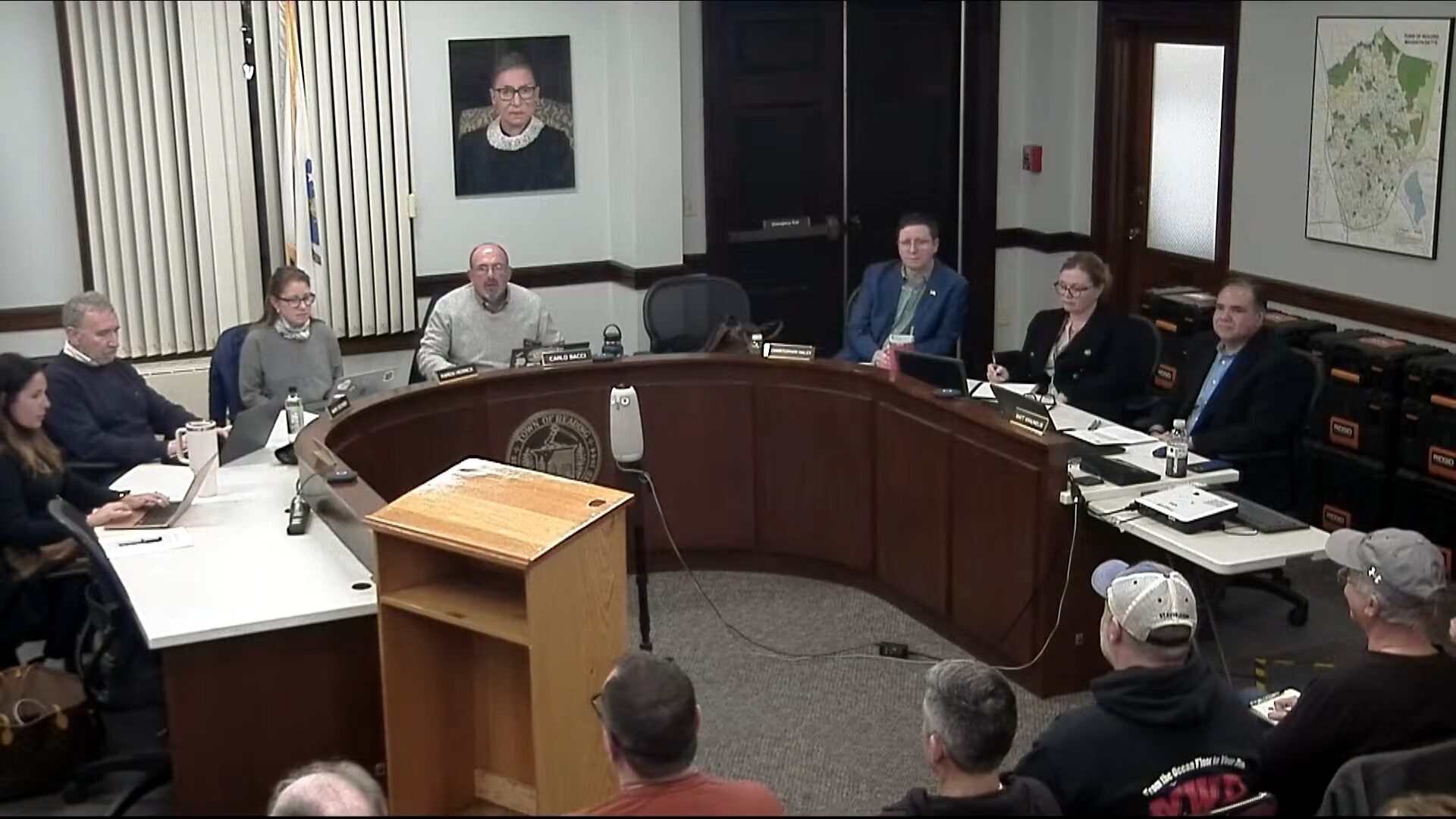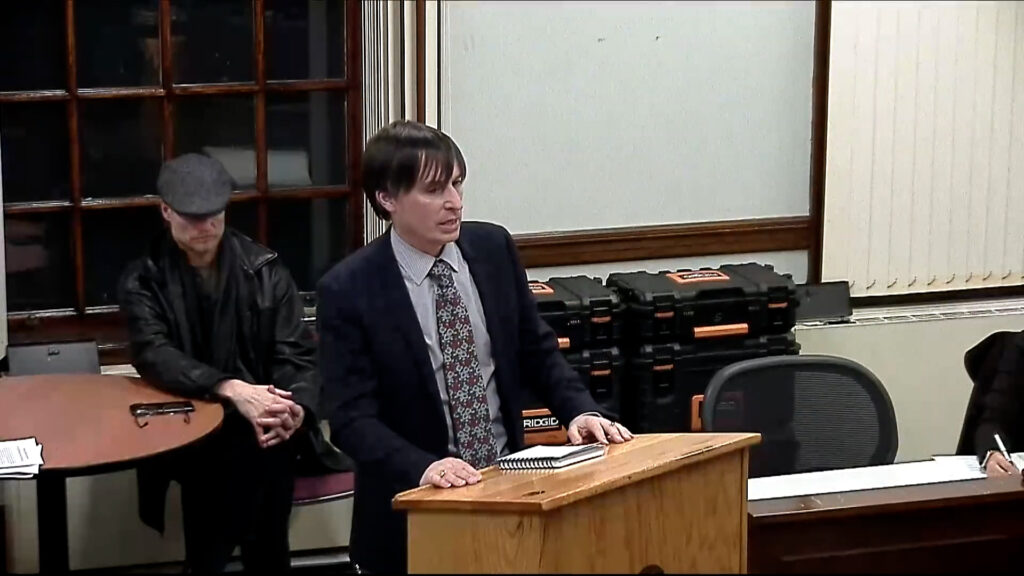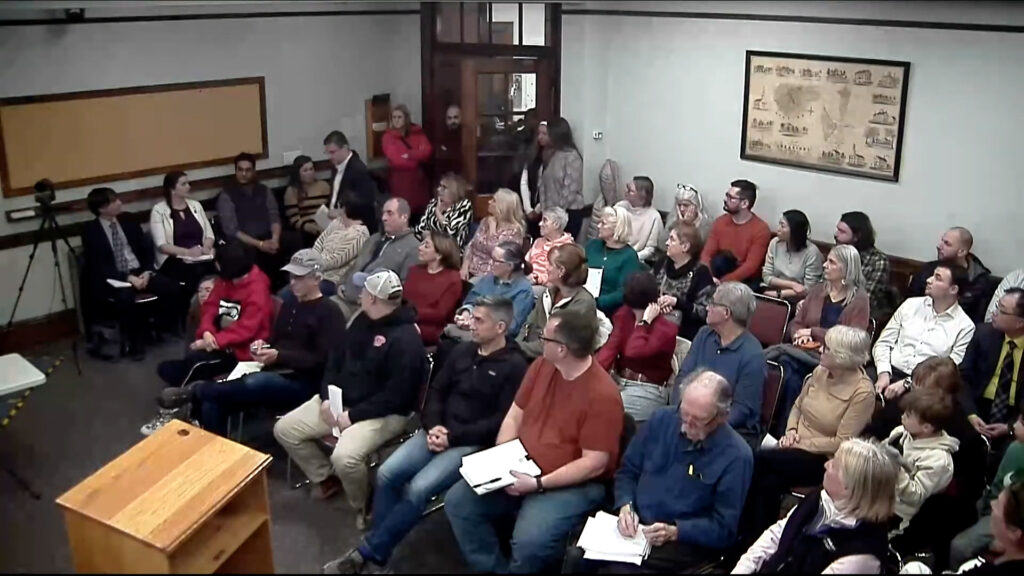
Reading, MA — After significant resident communication and input, the Select Board hosted representatives of the MBTA to its February 4 meeting to explain its reasoning regarding its proposal to construct a 4,500-foot spur in Reading from Woburn Street, north of the depot, to the Aberjona River on Willow Street. Residents and abutters expressed noise, pollution, and safety concerns during the meeting’s public comment period.

According to MBTA Rail Modernization Director Alistair Sawers, the second track line will create a place for trains to idle while waiting to return to Boston. Currently, trains wait at the depot but block trains returning from the far end of the line, which culminates in Haverhill. The turnaround will also allow for increased service from Reading to Boston. Trains would now depart from Reading every thirty minutes instead of the current timing of every forty-five minutes. Similar plans are proposed on other lines as well.
Reading-MBTA-turnback-250204smSawers explained that these proposals are part of the long-term planning for the MBTA to switch to electrified trains. He suggested that the change would improve riders’ access to all of the regional train stations and provide them with the benefit of integrated fare payment. Sawers also indicated that trains would idle on the track for about four and a half hours daily in an area abutting the newly renovated Maillet-Sommes-Morgan Conservation area. He suggested that this is farther away from the denser population area at the depot, where the trains now idle.
Sawers continued, noting that the area in question once had two tracks and that the railroad bed is still intact. Additionally, all of the current bridges and roadways have already been built to accommodate the double track. He also answered that the double tracks that already exist south of the depot, adjacent to the commercial and industrial area off Ash Street, face the wrong direction and would require multiple turns to accomplish the same result, which would take additional time. Thus, the proposed thirty-minute schedule would be impossible to maintain.
Select Board member Christopher Haley asked several pointed questions of Sawers, stating that the new track “is a want, not a need” for the MBTA. He continued questioning the increased service’s financial sense when the current schedule is underutilized. “I’m not going to sit here and jeopardize the safety and well-being of our residents,” Haley proclaimed. “Massachusetts is supposed to be a climate leader.”
Member Mark Dockser also expressed concern for the project while applauding the goals set forth by the MBTA. “The vision [for electrification] is marvelous, “ Dockser stated. “The question is how we get there.” After Dockser questioned why electrification testing could not be done on the Reading line, Sawers indicated that it was already being tested on the Fairmont line due to the pre-existing Amtrak electric lines.

MBTA representative Adam Kamoune admitted to the board that outreach to the town and its residents has “come up short.” He added that the MBTA will host a community meeting on February 25 at the Pleasant Street Center to answer specific questions regarding the track’s location and possible mitigation for noise and pollution. He also suggested that resident concerns and ideas on the project will be given full consideration.
“There is a difference between the simplest and the best, it feels like the simple [solution] is what we see thus far, it might not be the best,” Dockser added.
“We have a trust issue right now,” Kamoune admitted. “We need to consider and flesh out all the alternatives . . . and properly explain that instead of being dismissive.”
MBTA Environmental Compliance Officer Jeremy Fontaine also explained that the MBTA believes they have met all regulatory compliance requirements regarding notification to project abutters. He is unaware of any additional permits needed other than Conservation Commission approval.
Select Board member Karen Herrick commended the MBTA representatives for their willingness to listen to concerns and overall tone. She also suggested that a presentation with specific data could alleviate some of the community’s misinformation about the project. Chair Carlo Bacci agreed and suggested including real ridership data from before, during, and after the COVID-19 shutdowns.
“A twenty percent increase in riders sounds great, but not if it is up from zero,” Bacci quipped.
Bacci continued to suggest that there is “no way” that the project would not be detrimental to Reading. He concluded, noting to the assembled crowd of residents that although the Select Board has no vote on the matter, “We do have a say, and we will advocate for you,” Bacci promised.
The community information and input meeting on the MBTA proposal is scheduled for February 25 at 7:00 pm at the Pleasant Street Center.
